Trending
Opinion: How will Project 2025 impact game developers?
The Heritage Foundation's manifesto for the possible next administration could do great harm to many, including large portions of the game development community.

Featured Blog | This community-written post highlights the best of what the game industry has to offer. Read more like it on the Game Developer Blogs or learn how to Submit Your Own Blog Post
This article by video game music composer Winifred Phillips explores the technology of audio headphones built specifically for virtual reality. Topics include HRTF, haptic feedback, middleware compatibility, object based and ambisonic considerations.

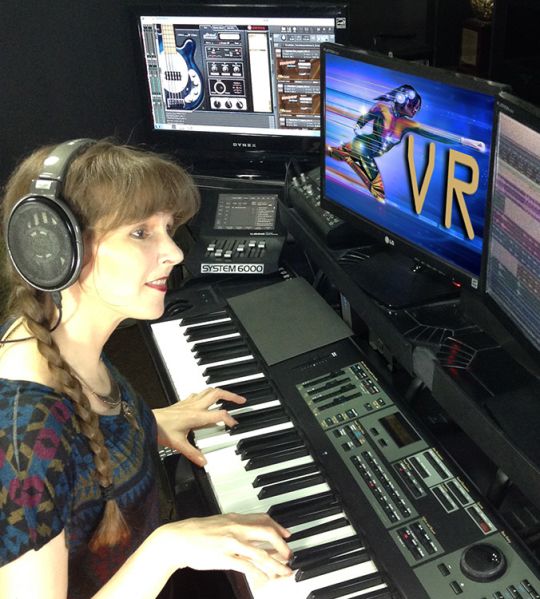 Recently, I've been composing music for some VR projects (more info on that soon), so I've been giving virtual reality a lot of thought, and have simultaneously been writing some articles here on the subject. Those have included a discussion of some interesting uses of virtual reality technology to benefit and inspire video game composers, and some of the top issues of concern for video game music composers and game audio folks creating content for VR projects.
Recently, I've been composing music for some VR projects (more info on that soon), so I've been giving virtual reality a lot of thought, and have simultaneously been writing some articles here on the subject. Those have included a discussion of some interesting uses of virtual reality technology to benefit and inspire video game composers, and some of the top issues of concern for video game music composers and game audio folks creating content for VR projects.
In this article I'd like to turn our attention towards the experience of the end user, and specifically, the primary interface with which users will be enjoying our audio content. So, let's talk about headphones! More specifically, let's talk about the newest incarnation of this device... headphones built specifically for VR!
This will be a two-part article (since there's a lot of ground to cover!) In part one, we'll be discussing these two headphone models:
OSSIC X
CEEKARS 4D
So let's get started!
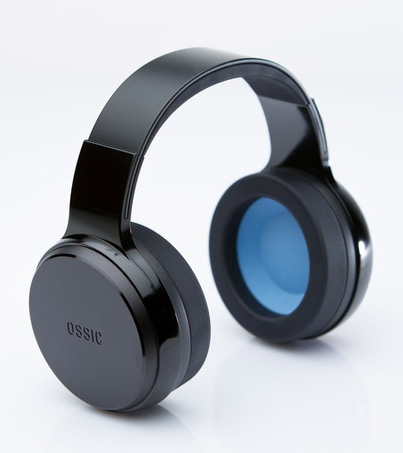 When the OSSIC X headphones were first announced two years ago, they were billed as the "Oculus for audio headphones." The claim, made by OSSIC founder and CEO Jason Riggs, received some justification in April 2016 when the product's Kickstarter campaign netted a whopping $2.7 million dollars, allowing the device to break Oculus' record as the largest VR crowdfunding campaign in history.
When the OSSIC X headphones were first announced two years ago, they were billed as the "Oculus for audio headphones." The claim, made by OSSIC founder and CEO Jason Riggs, received some justification in April 2016 when the product's Kickstarter campaign netted a whopping $2.7 million dollars, allowing the device to break Oculus' record as the largest VR crowdfunding campaign in history.
"There’s clearly a lot of demand for high-end, immersive audio for VR," writes Kent Bye, the host of the Voices of VR Podcast. He explores that idea further in an in-depth podcast interview with OSSIC CEO Jason Riggs, who discusses the strengths of the OSSIC X technology. One of the best advantages, according to Riggs, is the ability to free users from the need for physical speakers and monitor systems. "Ultimately (the OSSIC X) has the ability to render really high resolution 3D audio," Riggs states. "Nobody is going to have five hundred and seventy two speakers at home, but you can do that on headphones, and when it works right, I think ultimately headphones are going to be able to recreate 3D experiences that you just can't do on any grid of speakers."
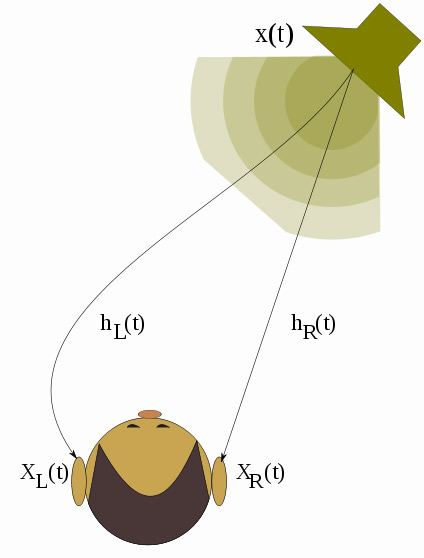 So, how does the OSSIC X work? It's all about the aural filtering effect of HRTF, otherwise known as Head Related Transfer Function (pictured left). We first discussed HRTF in an article from April of last year, but let's briefly review the concept again here. In order to place perceived sound at a specific location, we all depend on the unique configuration of our ears, as well as the size of our heads. We make determinations about sonic location based on the way that sounds transfer around our heads, into our ear canals, reaching our ear drums and subsequently our brains. Every little personalized quirk of our physical hearing apparatus impacts the way in which we register the locations of the sounds around us.
So, how does the OSSIC X work? It's all about the aural filtering effect of HRTF, otherwise known as Head Related Transfer Function (pictured left). We first discussed HRTF in an article from April of last year, but let's briefly review the concept again here. In order to place perceived sound at a specific location, we all depend on the unique configuration of our ears, as well as the size of our heads. We make determinations about sonic location based on the way that sounds transfer around our heads, into our ear canals, reaching our ear drums and subsequently our brains. Every little personalized quirk of our physical hearing apparatus impacts the way in which we register the locations of the sounds around us.
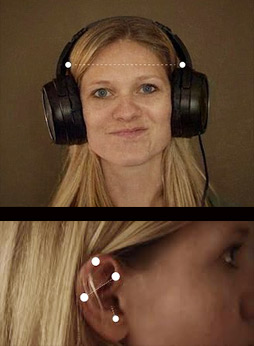 The OSSIC X headphones were designed to account for these variables. "OSSIC X instantly calibrates to your head and torso," states the product's Kickstarter page. "This enables incredibly accurate sound placement for a higher level of sound quality and immersion." In addition, the headphones calibrate to each wearer's ears by virtue of "individual anatomy calibration" (pictured right). This allows the headphones to provide the most personalized experience for each user.
The OSSIC X headphones were designed to account for these variables. "OSSIC X instantly calibrates to your head and torso," states the product's Kickstarter page. "This enables incredibly accurate sound placement for a higher level of sound quality and immersion." In addition, the headphones calibrate to each wearer's ears by virtue of "individual anatomy calibration" (pictured right). This allows the headphones to provide the most personalized experience for each user.
"Eight individual drivers work in tandem to play back sound to the correct portion of your ear," explains the product's Kickstarter page. "This allows your unique ear shape to naturally interact with the 3D sound field the same way it does in real life."
Here's a video from the OSSIC team that goes into more detail about how the OSSIC X headphones account for HRTF variables:
For game developers, the OSSIC designers have made special efforts to ensure that their device can be easily integrated into a gaming experience that delivers the most awesome video game music and sound possible. "While the OSSIC X already supports existing standard 2D formats such as stereo, 5.1, and 7.1, we want to make it easy for game and sound designers to go beyond," the OSSIC team tells us.
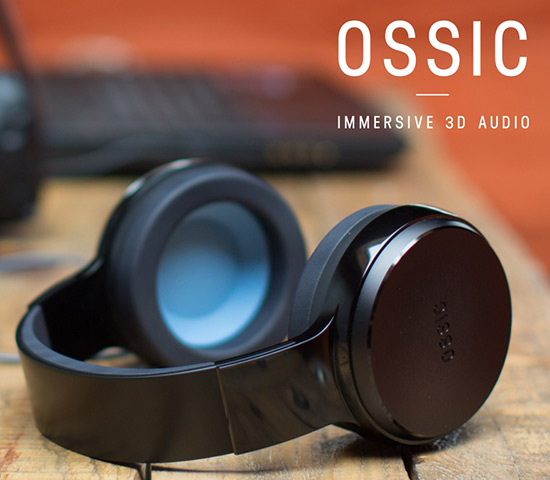 In order to do this, they have taken steps to facilitate the needs of game audio folks. "We are designing plugins that let natively 3D audio pass through to the listener. We already have a prototype FMOD plug-in running, and it sounds great and operates efficiently. We are testing it with some early developers now."
In order to do this, they have taken steps to facilitate the needs of game audio folks. "We are designing plugins that let natively 3D audio pass through to the listener. We already have a prototype FMOD plug-in running, and it sounds great and operates efficiently. We are testing it with some early developers now."
The OSSIC team isn't stopping with support for the most popular middleware applications, however. Their plans include support for newer 3D formats, object based formats, and ambisonic formats. If you'd like to read a further discussion of these concepts, there's a good explanation of object based audio on the Dolby Atmos site, and we previously discussed newer 3D formats and ambisonics in this article.
The OSSIC X is expected to start shipping to its Kickstarter backers in November 2016. Here's the full-length product info video produced by the OSSIC team:
 While the OSSIC X concentrates on a new technology for individual HRTF that brings new dimension to our VR audio experience, the CEEKARS 4D headphones (pictured right) take a very different approach. CEEKARS 4D wants us to both hear and feel the audio in our VR worlds.
While the OSSIC X concentrates on a new technology for individual HRTF that brings new dimension to our VR audio experience, the CEEKARS 4D headphones (pictured right) take a very different approach. CEEKARS 4D wants us to both hear and feel the audio in our VR worlds.
"We coined the term “4D Audio” to represent 3D Audio plus haptic feedback," says Mary Spio, the CEO of CEEKARS 4D developer Next Galaxy Corp. Discussing her company's goals in an interview with SECFilings.com, Spio points out what makes her new VR headphone technology unique. "Our patent-pending audio technology allows you to feel sound, which makes the experience even more realistic. It is the next generation in sound."
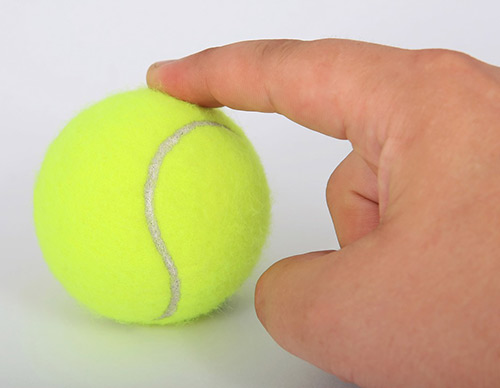 Many of us have likely encountered the concept of "haptic feedback" before, but for those who are puzzled, there's a thorough discussion available on the How Stuff Works site. In a nutshell, haptic feedback is the tactile stimuli we receive when we touch and interact with the world. When we pick up a ball, we feel the pressure and weight in our hands, as well as the texture of the object against our fingers (pictured left). But when we pick up a virtual ball in an imaginary world? Nothing. "Computer scientists have had great difficulty transferring this basic understanding of touch into their virtual reality systems," writes journalist William Harris of How Stuff Works. "Visual and auditory cues are easy to replicate in computer-generated models, but tactile cues are more problematic."
Many of us have likely encountered the concept of "haptic feedback" before, but for those who are puzzled, there's a thorough discussion available on the How Stuff Works site. In a nutshell, haptic feedback is the tactile stimuli we receive when we touch and interact with the world. When we pick up a ball, we feel the pressure and weight in our hands, as well as the texture of the object against our fingers (pictured left). But when we pick up a virtual ball in an imaginary world? Nothing. "Computer scientists have had great difficulty transferring this basic understanding of touch into their virtual reality systems," writes journalist William Harris of How Stuff Works. "Visual and auditory cues are easy to replicate in computer-generated models, but tactile cues are more problematic."
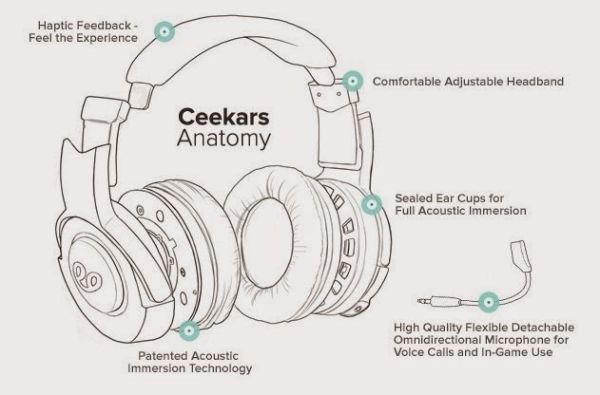 The CEEKARS 4D headphones attempt to address this problem by providing tactile feedback within the VR world. Their headphones design (pictured right) includes haptic actuators. These actuators (i.e. motors) work together to create vibrations along the length of the headband. Like the vibrations we're used to experiencing with console game controllers like the famous Dual Shock, the haptic feedback delivered by the CEEKARS 4D headphones will correspond to events within the gaming environment, increasing a gamer's sense of immersion.
The CEEKARS 4D headphones attempt to address this problem by providing tactile feedback within the VR world. Their headphones design (pictured right) includes haptic actuators. These actuators (i.e. motors) work together to create vibrations along the length of the headband. Like the vibrations we're used to experiencing with console game controllers like the famous Dual Shock, the haptic feedback delivered by the CEEKARS 4D headphones will correspond to events within the gaming environment, increasing a gamer's sense of immersion.
The headphones also include built-in audio processing to enhance the experience of three dimensional sound. "CEEKARS uses physics-based audio rendering that assesses the physical attributes of the VR environment and overlays appropriate geometric data," writes Seth Colaner of the Tom's Hardware site.
 This assessment of the VR landscape will purportedly include such variables as proximity and occlusion. "Ceekars 4D headphones try to take the idea of surround sound systems further than ever before to make sounds feel like an integral and dynamic part of the environment," observes tech journalist Dario Borghino of Gizmag.com. "For instance, say their creators, Ceekars let gamers experience sound differently depending on where they are in the environment, with noise becoming louder and clearer as they move toward their source or softer if it’s coming from behind a wall or a closed door."
This assessment of the VR landscape will purportedly include such variables as proximity and occlusion. "Ceekars 4D headphones try to take the idea of surround sound systems further than ever before to make sounds feel like an integral and dynamic part of the environment," observes tech journalist Dario Borghino of Gizmag.com. "For instance, say their creators, Ceekars let gamers experience sound differently depending on where they are in the environment, with noise becoming louder and clearer as they move toward their source or softer if it’s coming from behind a wall or a closed door."
In addition, the team at Next Galaxy Corp. designed the CEEKARS 4D headphones so that they are ready to go for indie developers looking to incorporate immersive sound into their VR projects. "CEEKARS 4D Headphones do not require special developer support," writes tech journalist Seth Colaner of Tom's Hardware. Without the need for special software development kits and plugins, content creators won't have to be VR audio experts, and will be freed from "having to resort to new techniques or sound manipulation to take advantage of the patented technology."

This ease of use is emphasized by CEO Mary Spio when discussing the use of the CEEKARS 4D Headphones with mobile devices. "Ultimately, we want CEEKARS to compensate for the limitations of audio in mobile devices," she says in an interview with the Tom's Hardware site. "I believe mobile is going to be what takes VR to the mainstream audiences. Everyone's got a mobile phone." (pictured above)
The CEEKARS 4D Headphones will be available in Q4 2016. In the meantime, here is a video produced by the CEEKARS 4D team about the capabilities of their VR headphones:
So that concludes this first installment of our two-part exploration of headphones designed specifically to accommodate the needs of virtual reality! I'll be continuing this discussion in my next installment, coming soon. I hope you enjoyed this article, and please feel free to let me know your thoughts in the comments below!
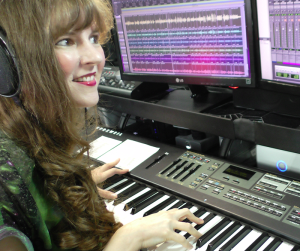 Winifred Phillips is an award-winning video game music composer whose most recent project is the triple-A first person shooter Homefront: The Revolution. Her credits include five of the most famous and popular franchises in video gaming: Assassin’s Creed, LittleBigPlanet, Total War, God of War, and The Sims. She is the author of the award-winning bestseller A COMPOSER'S GUIDE TO GAME MUSIC, published by the Massachusetts Institute of Technology Press. As a VR game music expert, she writes frequently on the future of music in virtual reality video games.
Winifred Phillips is an award-winning video game music composer whose most recent project is the triple-A first person shooter Homefront: The Revolution. Her credits include five of the most famous and popular franchises in video gaming: Assassin’s Creed, LittleBigPlanet, Total War, God of War, and The Sims. She is the author of the award-winning bestseller A COMPOSER'S GUIDE TO GAME MUSIC, published by the Massachusetts Institute of Technology Press. As a VR game music expert, she writes frequently on the future of music in virtual reality video games.
Follow her on Twitter @winphillips.
Read more about:
Featured BlogsYou May Also Like